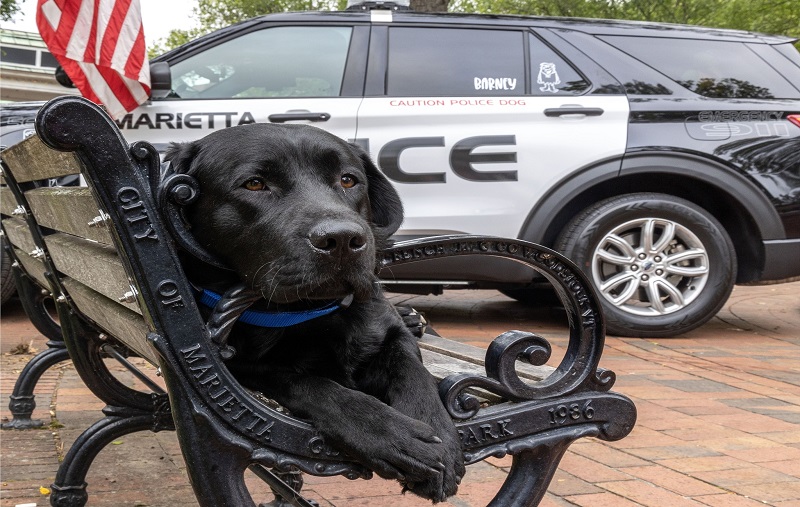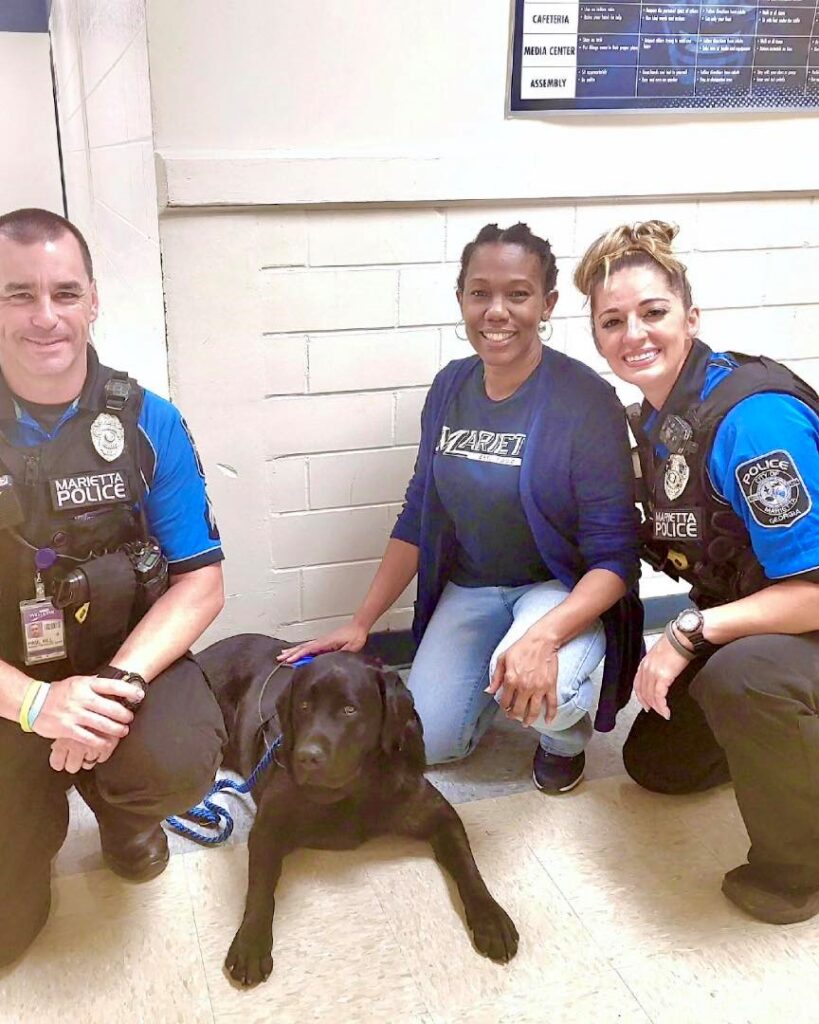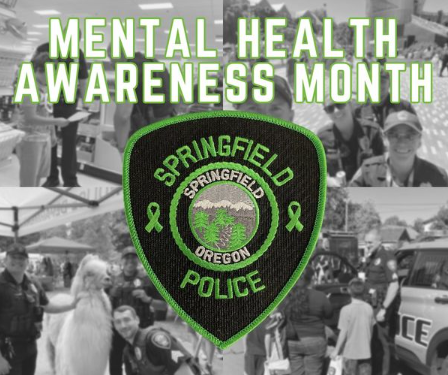
The fascinating feats of police service animals never cease to amaze. The Marietta Police Department’s crisis-response K9 “Barney” filled the primary officer role by calming a severely distraught woman who threatened to take her life, ultimately saving her from self-destruction.
The fine folks at Marietta PD provided the following synopsis of what transpired and how K9 Barney’s presence effectively soothed the in-crisis citizen for an extended period.
“K9 Officer Barney, normally assigned to the Marietta City Elementary Schools, helped de-escalate a woman in severe crisis last week. Since it’s summer break at the schools, Barney and his handler, Officer Hill, were helping the shift officers and were in the right place at the right time when it mattered most.”
When school is out for summer, cops ordinarily assigned as school resource officers (SROs) are typically re-assigned to the Patrol Division, beefing up staffing on the street beat, hence the availability of K9 Barney and Officer Hill (his handler). Even if the school were in session, the nature of this crisis-filled incident would have elicited the response of this duo.

(K9 Barney on duty at the school. Photo courtesy of the Marietta Police Department.)
Now that we’ve gleaned the beautiful face of K9 Barney, we see how he put it to work, along with an ideal demeanor for special duty.
“On June 7th, 2023, Barney and Officer Hill responded to a call where a woman locked herself in a bathroom, threatening to commit suicide. The woman (name withheld for her privacy) was distraught and told her pastor that she was ready to die.
“The pastor contacted 911 and requested officers respond. When the responding officers arrived, she was out of the bathroom and lying on the bed, extremely distraught. She told the officers that she ‘can’t live like this anymore’ and that she ‘did not want to go back to the hospital.’”
For whatever reason, she did not want to return to the hospital…until K9 Barney appeared and sidled up next to her. Sometimes people simply need a warm glow right next to them.
Minus a police canine, though, these situations can get quite hairy. Suicide-by-cop is an extreme example, whereby someone suffering a mental breakdown may be waving a weapon, refusing to put it down, then pointing it at police who, in context, can defend themselves with deadly force. It is a sad construct that LEOs sometimes find themselves having to confront, carrying that cross around thereafter.
Voluntary vs Involuntary Commitments
Involuntary commitments automatically engender police officers having to potentially take custody of the distraught individual by legally prescribed force, per stipulations clarified in the respective state’s Mental Health Act, spelling out statutory criteria to meet custodial grounds.
Conversely, a voluntary commitment, meaning the adversely impacted person willingly concedes they require professional help from a licensed clinician (psychiatrist), involves police officials aggregating resources for the person to receive help and ensuring they get into a clinical evaluation system.
In either case, law enforcement officers summon an ambulance via public safety dispatchers who make the call for that kind of service. Once on scene, the affected party is transported by ambulance to a nearby facility for intake and mental health services.
In Florida, the Mental Health Act (also referred to as the Baker Act) is delineated this way:
“The Baker Act provides legal procedures for mental health examination and treatment, including voluntary and involuntary examinations. It additionally protects the rights of all individuals examined or treated for mental illness in Florida. The Baker Act governs voluntary and involuntary admissions for mental health care, among other aspects of the state’s mental health program.”
As it pertains to Florida’s certified law enforcement personnel, “The Baker Act allows for involuntary examination (what some call emergency or involuntary commitment), which can be initiated by judges, law enforcement officials, physicians, or mental health professionals and close friends and relatives.” There must be evidence that the person:
- possibly has a mental illness.
- is in danger of becoming harmful to self or others or is self-neglectful.
With involuntary patients who meet the Mental Health Act criteria and pose resistance, law enforcement officers exercise sensitivity for the situation while also following through with their duties to ensure the person receives treatment for the episode they are enduring. Endemically, officer safety is paramount.
Annually, May is when we officially emphasize Mental Health Awareness Month. However, cops across America encounter these sensitive calls for service daily.

Per a Springfield Police Department bulletin posted in May 2023:
“Data suggests that nearly 1 in 5 American adults experience a diagnosable mental health condition each year and that 46% of Americans will meet the criteria for a diagnosable mental health condition during their lifetime, with half of them developing conditions by the age of 14.
“We frequently come in contact with community members who are working through mental health-related issues or are in crisis. Additionally, we must acknowledge that our mental health plays a vital role in our well-being and how we ‘show up’ in our service to the community members of Springfield.”
In my police career, most mentally burdened folks elected to voluntarily contact public safety authorities (or have someone do so on their behalf) and willingly enter a mental health unit at the hospital. The intoxicated ones are usually a different story, often creating the need for additional police resources to ensure the safety of all parties.
Generally, police agency protocols for this type of call for service are automatically two cops assigned, one of whom will take point (primary officer) and generate a police information report.
Having covered that, we get back to Barney befriending the distraught woman…
As the suicidal woman exhibited mental health burdens, “Barney followed his training, jumped on the bed, and laid down next to her. He allowed the distraught female to snuggle with him while his backup officers attempted to de-escalate her [mild conversation laced with reassurances that everything will be all right]. Barney’s presence and demeanor gave her the time to calm down and begin to relax.”
Thankfully, the individual under duress readily embraced Barney, sort of forgetting the clock, helping to bide the time…
“Unfortunately, the responding ambulance had to divert to a serious injury scene. In situations like this, the added response time can cause a distraught person to spiral further out of control. Officer Barney stayed diligent in his duties for over 45 minutes, never leaving her side. His companionship and presence made all the difference. When the ambulance crew arrived, the woman agreed to go voluntarily to the hospital for much-needed help.”
As for the diverted ambulance, albeit rare, it happens. Emergency operations centers occupied by superbly trained public safety dispatchers have protocol formulas dictating the prioritization of calls for service. For example, a gunshot victim is going to receive emergency medical attention/transport before someone with less severe circumstances, especially when first responders are already on-scene and aiding the citizen.
“Like all cities across our country, we have seen a notable increase in calls for help related to mental health. The addition of K9 Barney is just one more way Marietta is investing in the mental health of our community. We want to publicly thank everyone who worked to bring Barney here as a new specially trained crisis-response K9 officer,” the Marietta police bulletin explained.
Ultimately, a life seemingly on the brink was salvaged thanks to a uniquely trained police service animal whose physical presence was the right elixir before counseling was administered.